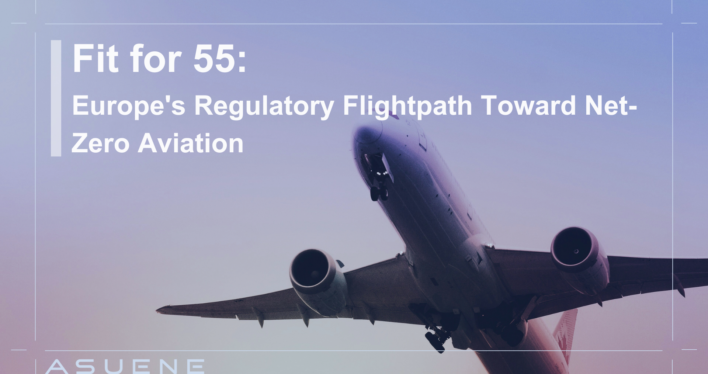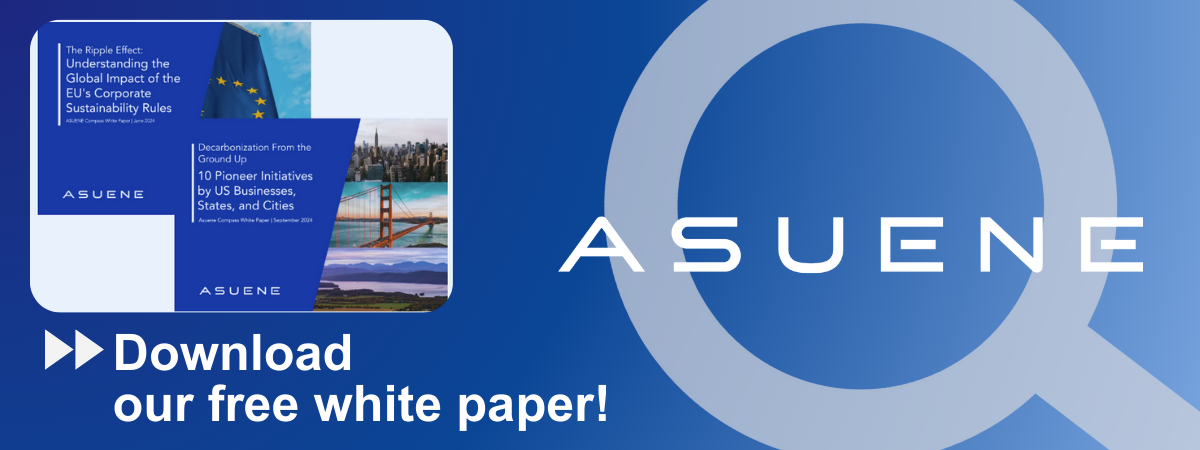- Article Summary
-
Overview
The European Union’s “Fit for 55” package represents one of the most ambitious climate policy frameworks in the world, aiming to reduce GHG emissions by at least 55% by 2030 (compared to 1990 levels) and to achieve net-zero emissions by 2050. As a growing source of emissions, the aviation sector is directly addressed in this wide-ranging legislative bundle through multiple complementary measures. In this article, we explore how Fit for 55 is reshaping the future of European and global aviation through regulatory, fiscal, and infrastructure-based reforms, with a special focus on Sustainable Aviation Fuel (SAF).
The Pillars of Fit for 55 Impacting Aviation
Fit for 55 is not a single regulation but a comprehensive suite of policy updates. The most aviation-relevant pillars include:
- ReFuelEU Aviation Regulation
- Revision of the EU Emissions Trading System (EU ETS)
- Energy Taxation Directive (ETD) Revision
- Alternative Fuels Infrastructure Regulation (AFIR)
These policies are strategically interlinked to create demand, reduce emissions, and drive investment in low-carbon aviation technologies.
ReFuelEU Aviation: Fueling the SAF Revolution
One of the most impactful components for aviation under the Fit for 55 framework is the ReFuelEU Aviation Regulation, which introduces binding mandates for the use of Sustainable Aviation Fuel (SAF) across the European Union. This regulation is designed to create a unified market demand signal and drive the production, distribution, and use of SAF at scale.
Under the regulation, fuel suppliers must ensure that all jet fuel made available at EU airports contains a minimum share of SAF. Starting in 2025, this blending mandate is set at 2%, and it increases incrementally every five years to reach 6% by 2030 and 70% by 2050. Importantly, the mandate also requires that a growing proportion of the SAF component consists of synthetic aviation fuels, or e-fuels, which are derived from renewable electricity and captured CO2. By 2050, at least 35% of the SAF blended into jet fuel must be synthetic.

The regulation applies to all departing flights from EU airports, regardless of the airline’s country of origin, thereby preventing competitive distortions and carbon leakage. To ensure transparency and accountability, fuel suppliers and airlines are obligated to report the volumes and sustainability credentials of the fuel they use. Annual compliance checks and penalties for non-conformance are built into the legislation, creating robust enforcement mechanisms.
ReFuelEU Aviation not only addresses supply-side challenges by stimulating SAF production but also reinforces demand certainty for the aviation industry. It incentivizes airlines to incorporate SAF into their decarbonization strategies and encourages long-term investment in SAF technologies and infrastructure. As such, the regulation is a cornerstone of the EU’s strategy to make sustainable flying a commercially viable and operationally scalable reality by mid-century.
EU ETS Reform: Full Emissions Accountability
The EU Emissions Trading System (EU ETS) has undergone substantial reforms to align more closely with the ambitious decarbonization targets laid out in the Fit for 55 package. One of the most significant changes is the complete elimination of free emissions allowances for intra-EU flights, starting in 2024. From this point forward, airlines operating within the European Union are required to purchase allowances for 100% of their verified CO2 emissions. This shift marks a clear departure from earlier leniencies and establishes a firmer price signal on carbon.
In addition to the end of free allowances, the overall emissions cap for the aviation sector under the EU ETS will be reduced annually, further tightening the system. This progressive reduction is designed to ensure that aviation emissions decline in tandem with the EU’s broader climate objectives. Airlines must now factor these escalating costs into their long-term operational planning.
One of the most forward-looking aspects of the reform is the integration of Sustainable Aviation Fuel (SAF) into the ETS framework. Since SAF emits significantly fewer lifecycle emissions than conventional jet fuel, its use results in reduced compliance obligations under the ETS. This makes SAF not only an environmental solution but also a financially strategic one, as it can lower the overall cost burden of emissions compliance.
Ultimately, this reform raises the effective carbon price for airlines and introduces stronger financial incentives to accelerate the adoption of low-emission fuels and more efficient aircraft technologies. It reinforces the message that polluting less is not just a moral imperative, it is an economic necessity in the EU’s evolving aviation landscape.

Tax Reform and Infrastructure Investment
Energy Taxation Directive (ETD) Revision:
As part of the Fit for 55 legislative suite, the revision of the Energy Taxation Directive (ETD) introduces critical fiscal reforms that target fossil fuel use in aviation. Historically, kerosene used for intra-EU flights was exempt from taxation, effectively subsidizing carbon-intensive air travel. Under the new rules, this exemption will be phased out beginning in 2025. Airlines operating within the EU will gradually be required to pay taxes on their fossil fuel consumption, increasing the cost of high-emission operations.
In parallel, Sustainable Aviation Fuel (SAF) is granted preferential tax treatment. This includes reduced or zero tax rates to improve its price competitiveness relative to kerosene. By creating a financial differential between fossil-based and renewable fuels, the directive provides a clear incentive for airlines to transition to SAF as a more economically viable option over time.
| Fuel Type | Tax Treatment Before 2025 | Tax Treatment After 2025 | Incentive Type |
|---|---|---|---|
| Kerosene (Fossil-based) | Exempt from taxation | Gradual taxation applied | None / Historical subsidy |
| Sustainable Aviation Fuel (SAF) | Limited or no tax incentives | Preferential tax treatment (reduced or zero rate) | Financial incentive to support uptake |
Alternative Fuels Infrastructure Regulation (AFIR):
To support the practical deployment of SAF at scale, the Alternative Fuels Infrastructure Regulation (AFIR) mandates that major EU airports invest in the necessary infrastructure. This includes the development of facilities for SAF storage, on-site blending, and dedicated refueling systems that ensure seamless integration with existing operations.
The regulation ensures that supply chain bottlenecks do not undermine SAF adoption. By requiring airports to be SAF-ready, the EU is proactively addressing the logistical challenges associated with distributing new fuel types. This foresight is crucial to aligning infrastructure with regulatory mandates and industry targets.
Together, the tax reforms and infrastructure investments function as a balanced policy mechanism—offering financial incentives for sustainable practices while gradually phasing out subsidies for polluting fuels. This dual approach is designed to accelerate the aviation sector’s transition toward lower-emission operations in a structured and enforceable manner.
Market Implications and Global Influence
The Fit for 55 package sets a global benchmark for aviation climate policy, significantly influencing both regional operations and global strategies. One of the most prominent effects is the surge in investment into SAF production capacity across Europe. Driven by clear regulatory targets and supportive incentives, fuel producers are ramping up infrastructure to meet the anticipated demand for low-carbon aviation fuel.
Meanwhile, airlines that continue to rely heavily on fossil-based jet fuels are encountering higher compliance costs. The tightening of emissions regulations and the removal of traditional tax exemptions are creating strong financial pressures, prompting companies to reconfigure fleet operations, fuel sourcing, and sustainability strategies.
Technological innovation is also accelerating. As SAF requirements become stricter and long-term decarbonization goals loom, there is a growing push to advance alternative propulsion methods such as electric and hydrogen-powered aviation. These emerging technologies, while still nascent, are beginning to attract increased R&D investments as the industry seeks long-term solutions.
Internationally, Fit for 55 is already generating a ripple effect. Airlines outside the EU, especially those operating flights to or from Europe, are compelled to adapt to these stringent rules. This global spillover effect not only amplifies the EU’s influence but also encourages other jurisdictions to strengthen their own aviation climate policies.
Already, fuel producers, airlines, and airport authorities are aligning capital expenditures to meet Fit for 55 mandates. Moreover, the package complements international measures such as ICAO’s CORSIA, but with stronger enforcement and timelines.
Conclusion
The EU’s Fit for 55 package is transforming aviation from a hard-to-abate sector into a climate innovation frontier. Through coordinated policy levers such as SAF mandates, emissions pricing, taxation reform, and infrastructure development, the initiative creates a robust ecosystem for decarbonizing air travel. While challenges remain around cost, scalability, and international harmonization, Europe’s regulatory clarity is providing a flightpath toward net-zero aviation by 2050. As other regions evaluate their own approaches, Fit for 55 stands as a model of integrated, enforceable, and future-ready climate governance.
Why Work with ASUENE Inc.?
Asuene is a key player in carbon accounting, offering a comprehensive platform that measures, reduces, and reports emissions, including Scope 1-3, with expertise in decarbonization. Asuene serves over 10,000 clients worldwide, providing an all-in-one solution that integrates GHG accounting, ESG supply chain management, a Carbon Credit exchange platform, and third-party verification.
ASUENE supports companies in achieving net-zero goals through advanced technology, consulting services, and an extensive network.


